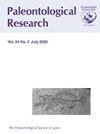Spirally-Coiled Radiolarians in the Latest Jurassic–Earliest Cretaceous
IF 0.6
4区 地球科学
Q3 PALEONTOLOGY
引用次数: 0
Abstract
Polycystine radiolarians have siliceous shells. The shells of Nassellaria, one of the major orders of radiolarians, are generally tower-like. Spiral structures are known in the shells (e.g. Sashida and Tonishi, 1991) and spines (e.g. De Wever et al., 2003) of other radiolarians; however, none with spiral shells had been found in Nassellaria. We found two different genera of Nassellaria with spiral shells from the latest Jurassic–earliest Cretaceous sample from the Mariana Trench. The findings are extremely rare and are important when considering the shell formation in radiolarians. The sample (181-R003) is a laminated tuffaceous radiolarian claystone or clayey radiolarite collected from the Mariana Trench oceanward slope (15°28.7′N, 147°50.6′E: 6,316 m water depth) by “Shinkai 6500” of JAMSTEC (Japan Agency for Marine-Earth Science and Technology). Because of the occurrences of the Loopus primitivus (Matsuoka and Yao) and Pseudodictyomitra carpatica (Lozyniak) (Matsuoka, 1998), the sample was considered to correspond to the lower part of the Pseudodictyomitra carpatica Zone (KR1) (uppermost Tithonian to lower Berriasian, uppermost Jurassic–lowermost Cretaceous) by Matsuoka and Ito (2019). Further detailed information on the sample and cooccurring radiolarian species are mentioned in Matsuoka (1998). The sample yielded two specimens having spiral shells. Such specimens are called “spiral-mutant” in this article. The first specimen of the spiral-mutant belongs to Svinitzium pseudopuga Dumitrica (Figure 1). The shell of the spiral-mutant specimen appears to be uncoiled up to the third septa from the top, but from the fourth septa onward, the shell tilts in opposite directions on the front side (FigSpirally-coiled radiolarians in the latest Jurassic–earliest Cretaceous侏罗纪晚期-白垩纪早期的螺旋盘绕放射虫
多胱氨酸放射虫有硅质外壳。放射虫主要目之一的纳塞拉虫的壳通常呈塔状。螺旋结构已知存在于其他放射虫的壳(如Sashida和Tonishi, 1991)和棘(如De Wever等人,2003)中;然而,在纳塞拉亚没有发现有螺旋壳的。我们从马里亚纳海沟侏罗纪晚期-白垩纪早期的样本中发现了两个不同的螺旋壳的纳塞拉属。这一发现非常罕见,在考虑放射虫的壳形成时非常重要。样品(181-R003)是由日本海洋地球科学技术机构(JAMSTEC)的“新海6500”(shinkhai 6500)在马里亚纳海沟向海斜坡(15°28.7′n, 147°50.6′e,水深6,316 m)采集的层状凝灰质放射虫粘土岩或粘土放射虫粘土岩。由于Loopus primitivus (Matsuoka and Yao)和Pseudodictyomitra carpatica (Lozyniak) (Matsuoka, 1998)的出现,Matsuoka和Ito(2019)认为该样品对应于Pseudodictyomitra carpatica带(KR1)的下部(Tithonian上部至Berriasian下部,侏罗纪上部-白垩纪下部)。Matsuoka(1998)提到了样本和共存放射虫种类的进一步详细信息。样品得到了两个具有螺旋壳的标本。这类标本在本文中被称为“螺旋突变体”。螺旋突变体的第一个标本属于Svinitzium pseudopuga Dumitrica(图1)。螺旋突变体标本的外壳似乎从顶部展开到第三个隔,但从第四个隔开始,外壳在正面向相反方向倾斜(图侏罗纪晚期-白垩纪早期螺旋卷曲的放射虫)
本文章由计算机程序翻译,如有差异,请以英文原文为准。
求助全文
约1分钟内获得全文
求助全文
来源期刊

Paleontological Research
PALEONTOLOGY-
CiteScore
1.60
自引率
0.00%
发文量
47
审稿时长
>12 weeks
期刊介绍:
Paleonotological Research (PR) is a quarterly, peer-reviewed international journal, which focuses on original contributions primarily in the area of paleontology but also covering a wide range of allied sciences. It has been published since 1997 as a successor to the former journal Transactions and Proceedings of the Palaeontological Society of Japan. The emphasis of contributions will include global and local perspectives, and contents can cover all ages (Precambrian to the Quaternary, including the present time).
 求助内容:
求助内容: 应助结果提醒方式:
应助结果提醒方式:


